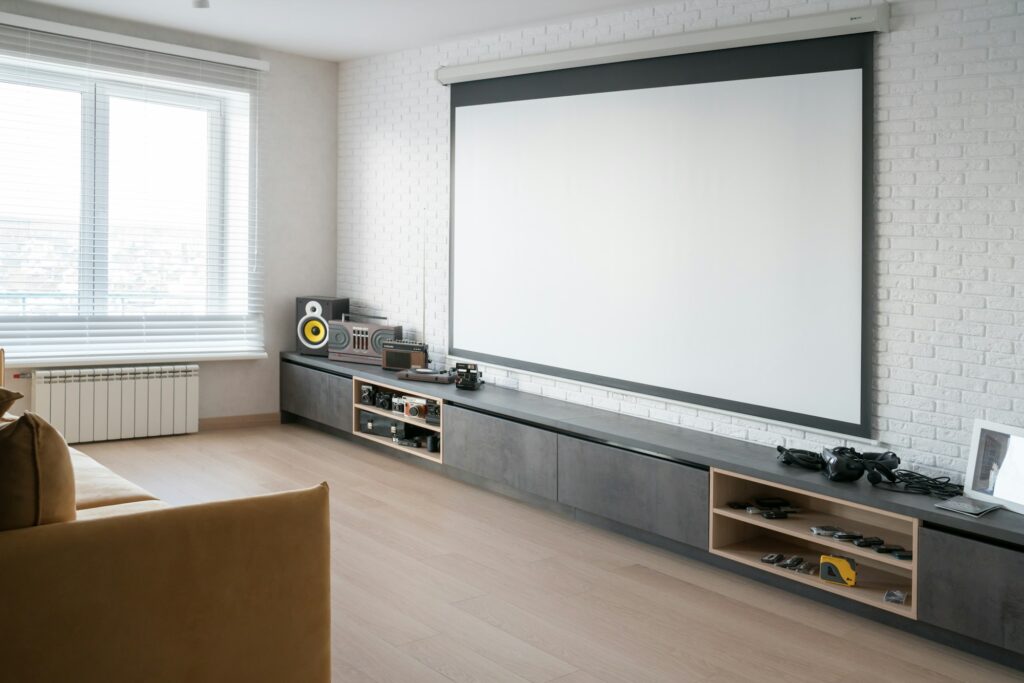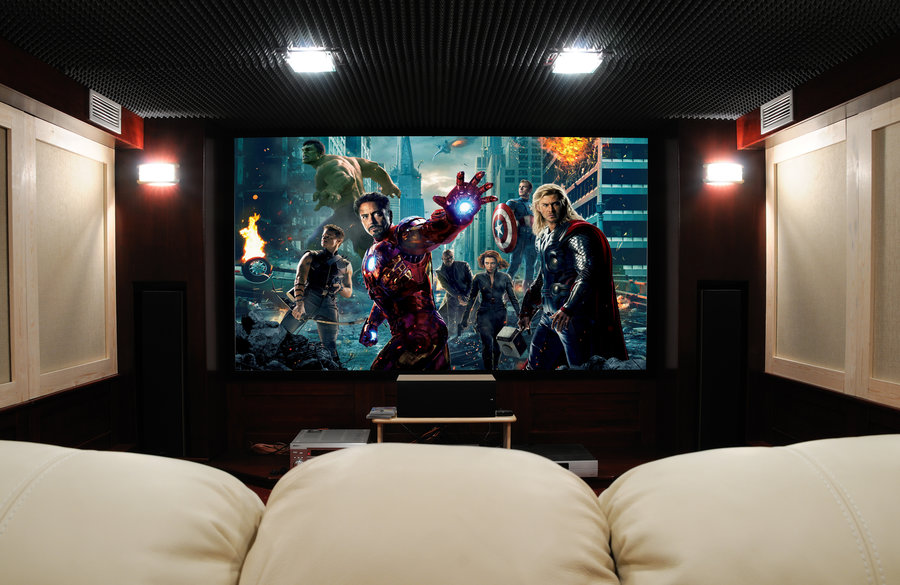In the era of technological advancement, the possibilities for transforming our living spaces have reached unprecedented heights. Among the myriad wonders that modern technology brings, one outstanding gem is the ability to turn our homes into captivating cinematic experiences. The gateway to this realm of immersive entertainment is the smart home theater setup, a marvel that allows us to seamlessly transplant the enchantment of the big screen into the cozy embrace of our homes. In this unfolding guide, we embark on a journey to explore the intricacies of creating a home theater experience that not only matches but rivals the magic of the cinema. Get ready to elevate your movie nights to an entirely new level as we guide you through the art of crafting a meticulously designed immersive smart home theater setup.
Benefits of Immersive Smart Home Theater

1. Cinematic Escape at Home
– Immerse yourself in the magic of the big screen without leaving the comfort of your home. Smart home theaters provide an unparalleled cinematic escape, transforming mundane evenings into extraordinary movie nights.
2. Tailored Viewing Experience
– Enjoy a personalized viewing experience with customizable settings. Adjust lighting, sound, and display preferences to suit your mood and the type of content you’re enjoying, providing a tailored experience for every movie or TV show.
3. Seamless Integration with Smart Devices
– Smart home theaters effortlessly integrate with various devices. Whether it’s voice-controlled commands, automated lighting, or synchronized audio systems, these setups create a seamless and interconnected entertainment ecosystem.
4. Enhanced Audiovisual Quality
– Experience a new dimension of audiovisual quality. Cutting-edge technology, including high-resolution displays and surround sound systems, ensures a heightened sense of realism, pulling you deeper into the on-screen action.
5. Comfort and Convenience
– Smart seating arrangements, ergonomic designs, and intuitive control systems prioritize comfort and convenience. Adjust your environment with the touch of a button or a simple voice command, enhancing the overall enjoyment of your cinematic escape.
6. Space Utilization and Aesthetics
– Maximize the utilization of your living space by transforming it into a dedicated home theater. Smart designs and aesthetics contribute to a visually pleasing environment, creating a space that is not only functional but also stylish.
7. Family and Social Bonding
– Bring family and friends together for memorable movie nights. The immersive nature of smart home theaters fosters social bonding, providing a shared experience that goes beyond traditional forms of entertainment.
8. Energy Efficiency
– Many smart home theaters come equipped with energy-efficient technologies. Automated lighting and power management systems contribute to a greener, more sustainable entertainment solution.
9. Future-Proof Entertainment
– Stay ahead of entertainment trends with a future-proof smart home theater. These setups often allow for easy upgrades, ensuring compatibility with emerging technologies and keeping your entertainment space technologically current.
10. Versatile Entertainment Hub
– Beyond movies and TV shows, smart home theaters can serve as versatile entertainment hubs. From gaming sessions to virtual reality experiences, these setups cater to a wide range of entertainment preferences.
Components of an Immersive Smart Home Theater
1. High-Resolution Display
– The centerpiece of any home theater is a high-resolution display. Choose from options like 4K LED TVs or projectors to ensure crisp, clear visuals that bring your favorite movies and shows to life.
2. Surround Sound System
– Elevate your audio experience with a surround sound system. Opt for Dolby Atmos or DTS:X for immersive, three-dimensional audio that surrounds you from all directions, enhancing the realism of on-screen action.
3. Media Source
– A reliable media source is essential for streaming high-quality content. This could be a smart TV, media player, or a dedicated home theater PC, ensuring seamless access to your favorite movies, TV shows, and streaming services.
4. Smart Home Hub
– Integrate smart home automation with a central hub. This allows you to control lighting, temperature, and other smart devices in your home theater with ease, creating a seamless and synchronized environment.
5. Comfortable Seating
– Invest in comfortable seating that enhances the viewing experience. Consider recliners, sectional sofas, or even dedicated home theater seating with ergonomic designs for optimal comfort during extended movie nights.
6. Ambient Lighting Control
– Set the right mood with ambient lighting control. Smart lighting systems allow you to adjust brightness and color to complement different scenes, creating a visually engaging and immersive atmosphere.
7. Smart Remote or Controller
– Simplify navigation with a smart remote or controller. These devices streamline the operation of various components, making it easy to adjust settings, switch between sources, and control smart home features.
8. Acoustic Treatments
– Enhance audio quality with acoustic treatments. Consider sound-absorbing panels, bass traps, and diffusers to optimize the acoustics of your home theater space, minimizing echoes and ensuring crystal-clear sound.
9. Streaming Devices
– Ensure versatility by incorporating streaming devices. Devices like Apple TV, Roku, or Amazon Fire Stick provide access to a wide range of streaming services, expanding your entertainment options.
10. Voice Control Integration
– Embrace the convenience of voice control. Integrate devices compatible with popular voice assistants like Amazon Alexa or Google Assistant to command your home theater with simple vocal instructions.
11. Gaming Console (Optional)
– For gaming enthusiasts, include a gaming console as part of your setup. Enjoy an immersive gaming experience on the big screen with high-quality visuals and surround sound.
12. Cable Management Systems
– Keep your space clutter-free with cable management systems. Conceal wires and cables to maintain a clean and organized look, preventing distractions during your cinematic experiences.
13. Screen Calibration Tools
– Fine-tune your display with screen calibration tools. Ensure colors, contrast, and brightness are optimized for your specific room, enhancing the overall visual quality.
14. Backup Power Solutions
– Safeguard against interruptions with backup power solutions. Uninterruptible Power Supply (UPS) units ensure your home theater remains operational during brief power outages, preventing data loss or system shutdowns.
15. Smart Integration with Virtual Reality (VR)
– Explore the realm of virtual reality by integrating VR devices with your home theater. VR headsets can provide an additional layer of immersion, especially for gaming and interactive experiences.
Choosing the Right Space for Your Immersive Smart Home Theater
1. Room Size and Layout
– Evaluate Dimensions: Consider the size of the room. A larger room allows for more flexibility in seating arrangements and screen size.
– Aspect Ratio: Choose a room with a layout that accommodates your desired aspect ratio for an ideal cinematic feel.
2. Acoustics
– Natural Sound Characteristics: Assess the room’s acoustics. Spaces with minimal echo and sound absorption contribute to a clearer and more immersive audio experience.
– Acoustic Treatments: Plan for the integration of acoustic treatments such as sound-absorbing panels and bass traps to optimize sound quality.
3. Lighting Conditions
– Natural and Artificial Lighting: Consider the room’s lighting conditions. Ideally, choose a space with the ability to control both natural and artificial lighting for a versatile viewing environment.
– Window Coverings: If the room has windows, invest in blackout curtains or blinds to eliminate external light during movie nights.
4. Ventilation and Climate Control
– Ventilation: Ensure proper ventilation to prevent overheating, especially if your equipment generates heat. Consider the installation of a ventilation system.
– Climate Control: Maintain a comfortable temperature with climate control options, as extremes in temperature can affect both equipment performance and viewer comfort.
5. Room Accessibility
– Proximity to Amenities: Choose a space that is easily accessible to amenities like restrooms and kitchens to enhance the overall convenience during movie nights.
– Entrance and Exit Points: Plan the placement of entrance and exit points to minimize disruptions during screenings.
6. Room Shape and Design
– Rectangular Spaces: Rectangular rooms are often preferred for home theaters as they offer more straightforward arrangements for seating and equipment placement.
– Design Aesthetics: Consider the existing design aesthetics of the room and how it aligns with your vision for a cinematic space.
7. Isolation from External Noise
– Sound Insulation: Assess the room’s insulation against external noise. Proper sound insulation minimizes disturbances, ensuring an immersive and undisturbed viewing experience.
– Location Considerations: Opt for a room located away from high-traffic areas or noisy appliances to enhance isolation.
8. Personal Preferences
– Preferred Viewing Angles: Choose a room layout that allows for optimal viewing angles from various seating positions.
– Aesthetic Preferences: Consider personal aesthetics and preferences when selecting a space, ensuring that it aligns with your vision for a cinematic escape.
Setting Up Your Immersive Smart Home Theater
1. Choose the Right Room
Select a room with minimal natural light and optimal acoustics. Consider the room’s size, shape, and layout. Additionally, assess the potential for soundproofing to enhance audio quality.
2. Install Acoustic Treatment
Begin by installing acoustic panels and bass traps to optimize sound within the room. This step is crucial for achieving a clear and immersive audio experience.
3. Position the Projector and Screen
Determine the ideal placement for your projector based on the room size and throw distance. Install a premium projection screen at the appropriate height and distance for optimal image quality.
4. Set Up Surround Sound System
Place speakers strategically to achieve an immersive audio experience. Follow guidelines for speaker placement, ensuring compatibility with audio formats like Dolby Atmos or DTS:X. Calibrate the system for balanced sound.
5. Connect Media Sources
Connect your chosen media source, whether it’s a streaming device, media server, or both. Ensure all cables are of high quality to maintain optimal signal transfer.
6. Integrate Smart Lighting
Install smart bulbs or LED strips strategically around the room. Sync the lighting with your content or choose preset modes to enhance the viewing ambiance. Consider dimmable lights for flexibility.
7. Set Up Smart Home Integration
Connect your home theater to smart home platforms and voice-controlled assistants. This allows for convenient control of lighting, audio, and other devices through voice commands or automation.
8. Arrange Comfortable Seating
Set up cinema-style seating for an authentic theater experience. Arrange seats for optimal viewing angles and comfort. If applicable, consider adding features like cup holders and integrated vibration systems.
9. Implement Control System
Establish a user-friendly control system, whether it’s a universal remote, touchscreen panel, or a dedicated mobile app. Ensure all components can be controlled effortlessly from a central point.
10. Test and Calibrate
Before your inaugural movie night, thoroughly test all components. Calibrate the projector, fine-tune audio settings, and confirm that smart home integration works seamlessly. Address any issues that may arise during testing.
11. Enhance Display Settings
If applicable, fine-tune display settings on your projector or screen. Adjust color balance, brightness, and contrast to optimize visual quality based on your preferences and the characteristics of your viewing environment.
12. Enjoy the Experience
With everything in place, sit back, relax, and enjoy your newly created immersive smart home theater. Revel in the cinematic magic and the convenience of having a theater experience within the comfort of your home.
Also Read: Luxury Smart Home Furnishings for Modern Interior Design
In conclusion, the journey to create an immersive smart home theater for cinematic experiences is a testament to the boundless possibilities of modern technology. By carefully selecting the right equipment, choosing an optimal space, and meticulously setting up each component, you have transformed your living space into a haven for unparalleled audiovisual indulgence. It’s an invitation to embark on a perpetual adventure, where each viewing becomes an event, and each event becomes a cherished memory. So, dim the lights, settle into your comfortable seating, and let the magic unfold as you immerse yourself in a world where the boundaries between reality and fiction blur, and cinematic dreams come to life in the heart of your home.
